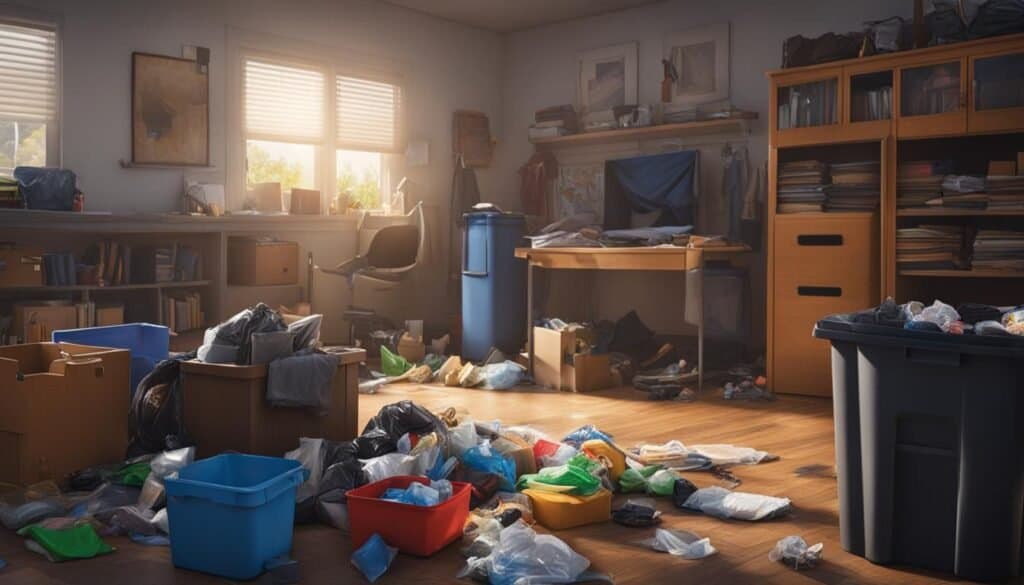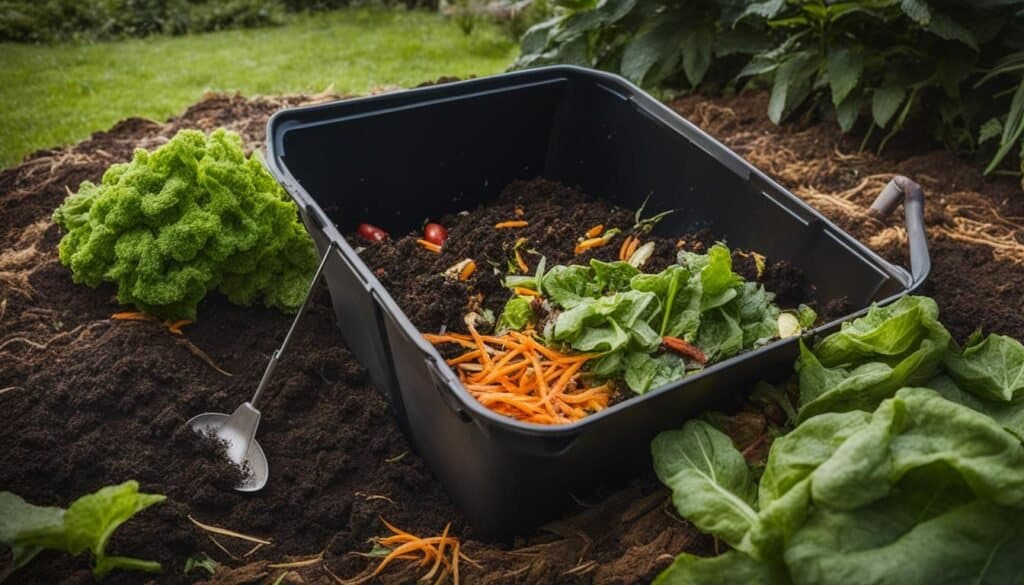As modern-day challenges push us to find eco-friendly ways to reduce waste at home, the zero waste movement has emerged as a solution for a more sustainable lifestyle. The shift is not only about an environmental responsibility but also about embracing a housekeeping approach that prioritizes waste reduction, with the ultimate goal of lowering how much waste we produce and transform our households into waste-free zones.
In essence, the zero waste philosophy promotes a circular mindset that allows us to save resources, improve our overall ecological footprint, and contribute to a healthier planet. Aiming to reduce household waste starts with small, incremental steps before venturing into the advanced level of zero waste living.
Key Takeaways
- The zero waste movement focuses on reducing waste at home and adopting a sustainable lifestyle.
- Effective housekeeping strategies can help lower the amount of waste produced in every household.
- Becoming eco-friendly begins with small, manageable steps that gradually lead to significant waste reduction.
- Zero waste living is not only beneficial for the environment but also promotes a healthier home and lifestyle.
- The goal of zero waste households is to minimize, if not eliminate, the amount of waste generated, ultimately contributing to a healthier planet.
101 Household Tips for Reducing Waste
General Waste Reduction
- Take inventory before shopping to avoid overbuying
- Meal plan and make shopping lists to only buy what you need
- Check expiration dates and use older items first
- Portion meals correctly to reduce leftovers and plate waste
- Eat leftovers and repurpose ingredients creatively
- Compost food scraps
- Freeze, pickle, or preserve perishables
- Follow the “2-Hour Rule” for leftovers
- Buy in bulk and use reusable containers
- Avoid single-use items like straws, cutlery, and cups
Food Storage
- Use airtight containers to keep food fresh
- Organize fridge and label storage containers
- Freeze breads, meats, produce, and leftovers
- Blanch vegetables before freezing
- Use ice cube trays for excess sauces or broths
- Set fridge temp to 40°F and freezer to 0°F
Grocery Shopping
- Shop with a list and meal plan
- Buy only what you need until next shopping trip
- Choose loose produce instead of pre-package
- Buy oddly shaped produce that may go to waste
- Choose products with less packaging
- Bring reusable bags and containers
- Shop at farmers markets and local shops
- Join a CSA or food co-op
- Request no bags, receipts, or samples
Food Prep
- Wash and prep produce as soon as possible
- Portion protein into servings before freezing
- Blanch vegetables to stop enzyme action
- Marinate proteins in reused containers
- Save vegetable trimmings for stock
- Use both edible and inedible parts creatively
- Pickle vegetables or make jam from aging fruit
- Dehydrate aging produce
- Regrow kitchen scraps like lettuce, onions, garlic
Around the House
- Use cloth napkins instead of paper
- Use cloth towels instead of paper towels
- Switch to rechargeable batteries
- Print double-sided and use scrap paper
- Cancel catalogs and junk mail
- Borrow, rent, or buy secondhand items
- Host clothing swaps with friends
- Repair items instead of replacing them
- Resell or donate unwanted items
Bathroom
- Install low-flow faucets and toilets
- Take shorter showers
- Use bar soap instead of body wash
- Look for plastic-free personal products
- Use safety or straight edge razors
- Use solid shampoo or soap bars
- Make your own cleaning and beauty products
- Compost hair clippings
- Reuse containers for DIY projects
Laundry
- Wash clothes in cold water when possible
- Only run full loads of laundry
- Hang-dry clothing instead of machine drying
- Use green detergent and spot treat stains
- Purchase concentrated detergent
- Use wool dryer balls instead of sheets
- Repair any damaged clothing
- Donate or reuse worn clothes
Travel and Transportation
- Bring reusable bags and bottles
- Pack food in reusable containers
- Say no to hotel room plastic amenities
- Take public transport, walk, or bike
- Consolidate trips to reduce driving
- Fly less frequently
- Offset air travel carbon emissions
- Rent, share, or borrow recreational gear
Special Events
- Use reusable decorations, plates, and utensils
- Buy decor secondhand or make your own
- Serve buffet-style to reduce waste
- Compost food scraps after the event
- Donate extra food to shelters
- Use online invitations and RSVPs
- Offer guests reusable water bottles as favors
Gardening
- Start a compost pile
- Use compost to fertilize your garden
- Plant a vegetable garden
- Install a rain barrel for water collection
- Use grey water from sinks/showers for plants
- Grow indoors with hydroponics
- Start a worm composting bin
- Mulch yard waste by mowing over leaves
- Rent tools instead of purchasing
- Share tools and equipment with neighbors
Pets
- Use reusable pet waste bags
- Switch to vegan pet food
- Buy in bulk to reduce packaging
- Use old linens and towels for bedding
- Donate old leashes, bowls, beds and toys
- Adopt don’t shop for pets
Holidays
- Use LED holiday lights
- Send e-cards instead of cards
- Wrap gifts in reused paper and bags
- Regift gently used items
- Make gifts instead of purchasing
Kids and School Supplies
- Pack waste-free lunches and snacks
- Use reusable food pouches and bottles
- Buy in bulk to reduce packaging
- Use reusable bags and lunchboxes
- Choose school supplies with recycled content
Conclusion
Reducing household waste takes some effort but saves money and helps the environment. Start with a few manageable changes from this list of 101 tips. Be mindful of consumption, creatively repurpose ingredients and items, and remember that small daily changes really add up over time. Every waste-reducing action counts!
The Surge of Zero Waste Living
Zero waste is an environmental movement and lifestyle that has seen a significant surge in interest and followers, leveraging modern platforms to spread its mission of sustainability and conservation. Demonstrating that an inverse relationship exists between waste production and resource preservation, zero waste living stresses the importance of curbing how much waste one produces and consequently the impact on the environment. In the U.S., increasing concern has arisen as individual waste generation has climbed to alarming rates, compelling cities like Boston and San Jose to strive for zero waste objectives. For beginners and veterans alike, zero waste principles can be adopted incrementally, by making daily conscious decisions to reduce, reuse, and recycle, progressing towards the ultimate goal of a zero waste household.
Understanding the Zero Waste Movement
The zero waste movement places an emphasis on conserving resources and reducing the environmental impact caused by waste. It encourages individuals to follow the 5Rs of Zero Waste — Refuse, Reduce, Reuse, Recycle, and Rot. These principles help guide people towards landfill diversion and a more sustainable lifestyle. By consciously reducing waste, reusing items wherever possible, recycling correctly, and composting organic waste, the movement aims to address the issues associated with waste production and its lasting effects.
The Impact of Household Waste in the U.S.
Household waste has a significant environmental impact, particularly in the United States. Statistics indicate that over 4.9 pounds of waste is generated per person daily. Landfills continue to expand, leading to a depletion of natural resources and a surge in methane emissions, a potent greenhouse gas. In response to this, cities across the nation have adopted zero waste goals, aiming to dramatically reduce waste production and prioritize environmental conservation.
Embracing Zero Waste Principles Gradually
Transitioning to a zero waste lifestyle does not require a complete overhaul overnight. Instead, individuals can take gradual steps towards adopting zero waste living practices by implementing the 5Rs of Zero Waste in their daily routines. Simple actions such as refusing single-use plastics, reusing containers, and composting food scraps can make a significant difference in waste reduction and resource preservation. By consistently making conscious decisions, anyone can progress toward a more sustainable and eco-friendly lifestyle.
Getting Started with Household Tips for Waste Reduction
Embarking on the journey to reduce household waste requires the right approach and willingness to change specific habits, with simple waste reduction practices now transforming into a long-term commitment to sustainability. A few steps can help jump-start this transition and create a significant impact on reducing waste at home.
Conduct a Waste Audit
To get started, a waste audit serves as a crucial initial step, allowing an insightful snapshot of current waste-generation habits. By analyzing and sorting out one’s trash, a comprehensive understanding of which items are discarded most frequently can be achieved. This knowledge then forms the basis for strategic planning on how to eliminate these items through smarter purchasing choices, repurposing, and recycling.
Setting Achievable Goals for Waste Reduction
Establishing attainable targets for waste reduction is vital for progress and motivation. These goals can take many forms, ranging from reducing single-use plastics to starting a compost system at home. Breaking down the objectives into smaller milestones enables individuals to systematically tackle each aspect of waste generation and inculcate a lifetime habit of sustainability. A few simple goals to consider include:
- Reduce single-use plastics: Prefer reusable alternatives wherever possible, such as cloth grocery bags and stainless-steel water bottles.
- Start a home compost system: Divert food scraps and yard waste to a compost pile instead of the trash to create nutrient-rich soil for gardening.
- Opt for reusables and recyclables: Purchase items with minimal packaging and choose those made from recycled materials when possible.
- Shop smarter: Plan meals and grocery lists to avoid overbuying perishable items that may end up as waste.
By implementing these practices to achieve set targets, waste reduction becomes an integral part of one’s daily routine, gradually transforming household management to align with sustainable living principles.
Refusing Unnecessary Items
As the first ‘R’ of the zero waste principles, refusing plays an essential role in reducing household waste. The practice of refusing involves turning down freebies, ranging from promotional gear to plastic utensils and extra packaging—items that add up to refuse waste production.
By consciously declining such items, we can greatly minimize packaging waste and curb our contribution to plastic pollution. More often than not, these freebies, especially refuse disposable products, are designed for short-lived utility but persist in the environment for an extended time. A seemingly small act such as refusing can have a substantial positive effect on the environment.
To solidify the habit of refusing unnecessary items, try the following:
- When ordering takeout, ask restaurants to exclude plastic utensils and other disposable items that you don’t need.
- Carry a reusable water bottle and refuse plastic water bottles at events or while traveling.
- Politely decline promotional items, such as keychains and pens, that you won’t use.
- Opt for reusable shopping bags and forgo plastic grocery bags when you shop.
By actively integrating the practice of refusing single-use items and unnecessary freebies into our daily lives, we become more conscious consumers and contribute to a sustainable lifestyle that significantly reduces waste generation and minimizes our environmental footprint.
Decluttering and the Power of Reduction

Decluttering may seem like a minor change in our day-to-day lives, but its impact on waste reduction cannot be underestimated. The minimalist trend, propelled by Marie Kondo’s philosophy of holding onto only what “sparks joy,” inherently fosters a mindset that aims to reduce the amount of waste produced by households.
The Influence of Marie Kondo and Minimalism
Marie Kondo has inspired countless individuals to embrace minimalism, taking a thoughtful approach to their material possessions and letting go of items that no longer serve a purpose. The ripple effect of decluttering not only creates a more organized and intentional living space, but also significantly minimizes our environmental footprint by reducing the potential for waste.
Thrifting and Second-hand Markets to Minimize Waste
As more people declutter their lives, there is a surge of second-hand goods entering the market. Thrift stores, consignment shops, and online market places have become increasingly popular venues for selling and buying gently used items, expanding the life cycle of these products. Sellers can recoup some of the original value while buyers save between 20-85%, making the second-hand market an economically viable and sustainable choice for acquiring new belongings.
Recyclable goods, such as clothing, appliances, and furniture, play a crucial role in our efforts to minimize waste. By considering alternate avenues like selling online or donating to thrift stores, we can not only keep our homes clutter-free but also contribute to a more circular economy and promote a sense of environmental responsibility – a win-win for all.
Reusing Items Around the Home

Incorporating reuse into our daily lives is a crucial aspect of a zero waste lifestyle. By repurposing and upcycling common household items, we can extend their lifecycles, minimize waste and embrace renewable options in an increasingly disposable world.
Alternatives to Disposable Products
An effective way to eliminate single-use products is by investing in reusable alternatives. For instance, replacing plastic food storage bags with beeswax wraps and reusable silicone bags can have a significant impact on minimizing kitchen waste. Opting for cloth rags instead of paper towels will not only save money but also reduce the amount of waste generated. When it comes to beverages, choosing options like box wine or using a refillable growler instead of purchasing individually bottled drinks supports the eco-friendly reuse mindset gracefully.
Ideas for Repurposing Common Household Goods
There are countless ways to get creative with home goods reuse. Some simple yet effective ideas include:
- Using empty mason jars from pasta sauces or other products as storage containers, drinking glasses, or even as planters for herbs or small plants.
- Opting for refillable containers at bulk-stores to minimize packaging waste.
- Repurposing old t-shirts or sheets as cleaning cloths, dish towels, or even as DIY reusable shopping bags.
- Transforming empty cardboard boxes from deliveries into storage solutions or as eco-friendly gift wrapping options.
Incorporating these upcycling and repurposing habits into our daily routine not only helps to reduce overall waste but also fosters a sense of environmental stewardship and resourcefulness that can inspire and motivate those around us to follow suit.
Recycling: Understanding Best Practices

Recycling is a critical component in the fight against household waste. Yet, the focus should not be on recycling more but rather on generating less waste in the first place. When recycling is necessary, adhering to local recycling rules is essential to ensure efficiency and effectiveness within the recycling process.
Consumer choices, such as purchasing products made from recycled materials, contribute to creating a closed-loop system. This approach promotes the reuse of materials and conserves the energy and resources that would otherwise be used in processing virgin materials.
Environmental conservation can be significantly enhanced by following recycling best practices, leading to more sustainable waste management.
By familiarizing ourselves with various recyclable materials and their respective recycling programs, we can make a substantial impact on environmental conservation. Below are some essential tips for recycling best practices:
- Always clean and rinse containers before recycling to avoid contamination.
- Separate materials according to your local recycling guidelines to ensure they are processed correctly.
- Avoid “wishcycling” – do not place non-recyclable items in the recycling bin hoping they will be recycled.
- Look for labels and symbols that identify packaging materials as recyclable.
- Opt for products with minimal packaging and those made from recycled materials.
Beyond following these guidelines, increased awareness of the recycling industry’s dynamics can help empower us as consumers. For instance, understanding the significance of recycling markets and their fluctuations can inform our choices and promote more sustainable habits.
In conclusion, recycling remains an indispensable aspect of not just reducing household waste but the overall goal of environmental stewardship. Committing to recycling best practices and sustainable waste management can lead to substantial positive impacts on our planet.
Composting, a Cornerstone of Zero Waste

As an integral part of zero waste living, composting can have a significant impact on reducing one’s waste profile, while also contributing to environmental stewardship. Home composting, in particular, is a manageable practice that can turn organic waste into valuable, nutrient-rich compost for your garden. Let’s delve into the basics of composting at home and explore the benefits of diverting organic waste from landfills.
Basics of Composting at Home
Composting at home involves the simple process of breaking down food scraps, yard waste, and other organic materials into nutrient-rich humus, or compost. This can be accomplished through various methods, such as using a compost bin, tumbler, or constructing your own compost pile. The key to successful composting is maintaining a proper balance of “green” materials (food scraps and plant material) and “brown” materials (dried leaves, paper, or cardboard), which provide the necessary carbon and nitrogen that microorganisms require to decompose the matter effectively.
Eco-friendly composting tips include:
- Chopping or shredding food scraps and yard waste into smaller pieces to speed up decomposition
- Turning or mixing the compost pile regularly to provide oxygen, which aids in breaking down organic material
- Moistening the pile if it becomes too dry, as moisture is essential for decomposition
- Incorporating compostable dish scrubbers or unbleached paper products into the pile
The Benefits of Diverting Organic Waste from Landfills
Diverting organic waste from landfills not only reduces the amount of trash each household generates, but it also mitigates the production of methane – a potent greenhouse gas. Landfilled organic waste breaks down anaerobically (without oxygen), which leads to methane production. By composting, that waste is broken down aerobically (with oxygen), significantly cutting down methane emissions. Furthermore, the end product of composting, the nutrient-rich humus, can be used in a variety of garden composting applications, such as:
Enhancing soil structure, fertility, and moisture retention, promoting healthier plant growth
Reducing erosion, runoff, and the need for chemical fertilizers
Suppressing plant diseases and pests by encouraging the growth of beneficial microorganisms
Composting, in essence, exemplifies the principle of zero waste living, transforming what would be a waste product into a valuable resource. By integrating composting into your daily habits, you embark on a journey towards a more eco-conscious life, working together with nature to reduce waste and support a healthier environment.
Conclusion on Household Tips for Waste Reduction
Embracing zero waste practices is a transformative journey that requires constant awareness and dedication to sustainability. By integrating waste reduction measures into our daily routines, we can make lasting changes that benefit both ourselves and the larger environment.
Integrating Zero Waste Practices into Daily Life
Adopting zero waste habits is paramount to reducing our environmental footprint. From refusing unnecessary items to adopting sustainable daily habits, we can make a meaningful difference in our personal lives and contribute to a more sustainable future. Furthermore, integrating zero waste practices into our lifestyles often results in a more organized, cost-effective, and purposeful way of life.
Maintaining a Zero Waste Mindset for Long-term Impact
Mindfulness and deliberate action lie at the heart of maintaining a zero waste lifestyle. By consistently committing to eco-friendly choices and striving for improvement rather than perfection, we position ourselves to make a lasting environmental impact. Through continuous dedication, the zero waste mindset blossoms into a sustainable way of life that fosters a healthier planet for generations to come.
FAQ on Ways to Reduce Waste
Q: What are some easy ways to reduce household waste?
A: You can reduce the amount of waste you create by using reusable containers, cloth napkins, and rechargeable batteries. Additionally, you can repurpose items, such as egg cartons and paper waste, whenever possible.
Q: How can I reduce food waste at home?
A: To reduce food waste, you can use coffee grounds in your garden, save leftovers for another meal, and buy items with minimal packaging. Additionally, using a travel mug and carrying reusable bags can help reduce food waste when dining out or grocery shopping.
Q: What are some effective ways to reduce the amount of single-use items in my household?
A: You can reduce your waste by using cloth napkins instead of paper napkins, opting for a reusable mug instead of single-use cups, and utilizing silverware instead of disposable utensils.
Q: How can I dispose of hazardous waste in a responsible manner?
A: To dispose of hazardous waste, such as rechargeable batteries and plastic bags, you should find designated drop-off locations in your area or utilize specific recycling programs that cater to hazardous materials. It’s crucial to avoid throwing hazardous waste in the regular trash to protect the environment.
Q: What are some ways to reduce the amount of junk mail I receive?
A: You can reduce the amount of junk mail you receive by opting out of unsolicited mailing lists, signing up for electronic statements whenever possible, and contacting specific mailers to request removal from their distribution lists.
Q: How can I repurpose goods around my home to help reduce waste?
A: You can repurpose household items, like empty jars or bottles, into storage containers or decorative pieces. Additionally, creating arts and crafts from materials that would typically be thrown away is an effective way to repurpose and reduce waste.
Q: Can reducing household waste also save money?
A: Yes, reducing your waste can help save you money in the long run. By utilizing reusable items and reducing unnecessary purchases, you can lower your expenses and minimize the impact on the environment.
Q: What are some tips for reducing the amount of paper waste in my household?
A: To reduce paper waste, you can opt for electronic communication and billing, utilize both sides of a paper before disposal, and recycle paper whenever possible. Additionally, considering the purchase of post-consumer recycled products can help reduce the demand for new paper goods.
Q: How can I reduce the amount of plastic waste in my daily routine?
A: To reduce plastic waste, you can buy reusable items, such as shopping bags and water bottles, and avoid purchasing products that come in excessive plastic packaging. Choosing products with minimal or biodegradable packaging can also save you money and reduce your impact on the environment.
Q: Are there specific ways to reduce the amount of waste generated from household cleaning?
A: Yes, you can reduce your waste from household cleaning by using concentrated or refillable cleaning products, purchasing items in bulk to minimize packaging, and reusing materials, such as old towels or t-shirts, as cleaning rags. This approach can help reduce the waste stream from cleaning supplies in your home.





Leave a Reply